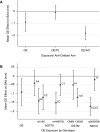Pretreatment with Antioxidants Augments the Acute Arterial Vasoconstriction Caused by Diesel Exhaust Inhalation
- PMID: 26599707
- PMCID: PMC4872652
- DOI: 10.1164/rccm.201506-1247OC
Pretreatment with Antioxidants Augments the Acute Arterial Vasoconstriction Caused by Diesel Exhaust Inhalation
Abstract
Rationale: Diesel exhaust inhalation, which is the model traffic-related air pollutant exposure, is associated with vascular dysfunction.
Objectives: To determine whether healthy subjects exposed to diesel exhaust exhibit acute vasoconstriction and whether this effect could be modified by the use of antioxidants or by common variants in the angiotensin II type 1 receptor (AGTR1) and other candidate genes.
Methods: In a genotype-stratified, double-blind, four-way crossover study, 21 healthy adult subjects were exposed at rest in a randomized, balanced order to diesel exhaust (200 μg/m(3) particulate matter with an aerodynamic diameter ≤ 2.5 μm [PM2.5]) and filtered air, and to pretreatment with antioxidants (N-acetylcysteine and ascorbate) and placebo. Before and after each exposure, brachial artery diameter (BAd) was assessed using ultrasound. Changes in BAd were compared across pretreatment and exposure sessions. Gene-exposure interactions were evaluated in the AGTR1 A1166C polymorphism, on which recruitment was stratified, and other candidate genes, including TRPV1 and GSTM1.
Measurements and main results: Compared with filtered air, exposure to diesel exhaust resulted in a significant reduction in BAd (mean, -0.09 mm, 95% confidence interval [CI], -0.01 to -0.17; P = 0.03). Pretreatment with antioxidants augmented diesel exhaust-related vasoconstriction with a mean change in BAd of -0.18 mm (95% CI, -0.28 to -0.07 mm; P = 0.001). Diesel exhaust-related vasoconstriction was primarily observed in the variant alleles of AGTR1 and TRPV1. No association was found between diesel exhaust inhalation and flow-mediated dilation.
Conclusions: We confirmed that short-term exposure to diesel exhaust in healthy subjects is associated with acute vasoconstriction in a conductance artery and found suggestive evidence of involvement of nociception and renin-angiotensin systems in this effect. Pretreatment with an antioxidant regimen increased vasoconstriction.
Keywords: air pollution; antioxidants; cardiovascular physiological processes/drug effects; environmental exposures.
Figures

Comment in
-
How Can We Protect Susceptible Individuals from the Adverse Cardiovascular Effects of Air Pollution?Am J Respir Crit Care Med. 2016 May 1;193(9):940-2. doi: 10.1164/rccm.201512-2447ED. Am J Respir Crit Care Med. 2016. PMID: 27128701 Free PMC article. No abstract available.
References
-
- Brook RD, Rajagopalan S, Pope CA, III, Brook JR, Bhatnagar A, Diez-Roux AV, Holguin F, Hong Y, Luepker RV, Mittleman MA, et al. American Heart Association Council on Epidemiology and Prevention, Council on the Kidney in Cardiovascular Disease, and Council on Nutrition, Physical Activity and Metabolism. Particulate matter air pollution and cardiovascular disease: an update to the scientific statement from the American Heart Association. Circulation. 2010;121:2331–2378. - PubMed
-
- Newby DE, Mannucci PM, Tell GS, Baccarelli AA, Brook RD, Donaldson K, Forastiere F, Franchini M, Franco OH, Graham I, et al. ESC Working Group on Thrombosis, European Association for Cardiovascular Prevention and Rehabilitation; ESC Heart Failure Association. Expert position paper on air pollution and cardiovascular disease. Eur Heart J. 2015;36:83–93b. - PMC - PubMed
-
- Donaldson K, Duffin R, Langrish JP, Miller MR, Mills NL, Poland CA, Raftis J, Shah A, Shaw CA, Newby DE. Nanoparticles and the cardiovascular system: a critical review. Nanomedicine (Lond) 2013;8:403–423. - PubMed
-
- Bots ML, Westerink J, Rabelink TJ, de Koning EJ. Assessment of flow-mediated vasodilatation (FMD) of the brachial artery: effects of technical aspects of the FMD measurement on the FMD response. Eur Heart J. 2005;26:363–368. - PubMed
Publication types
MeSH terms
Substances
Grants and funding
LinkOut - more resources
Full Text Sources
Other Literature Sources
Medical
Research Materials
Miscellaneous

